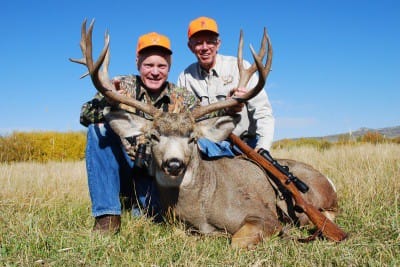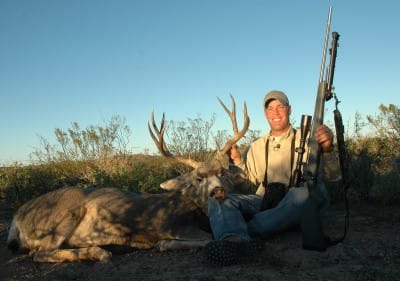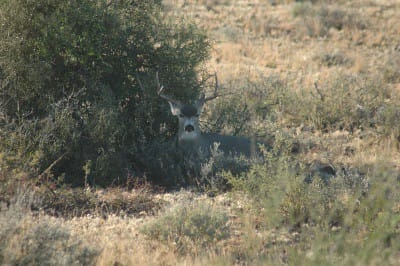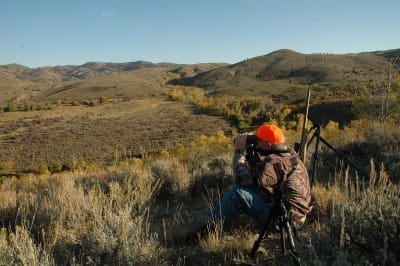
I guess we all know that mule deer hunting today isn’t what it used to be. Of course, what you see depends upon where you stand. If you start mule deer hunting this fall then you’ll probably find it pretty great. If you did your first mule deer hunting back in the 60s or 70s, well, things were different. It’s easy to say there were a lot more deer and a lot fewer hunters, but that’s not necessarily true. Mule deer numbers will always fluctuate, going up quickly when times are good, and down when you have hard winters or dry spells. And when I was a kid mule deer tags were generally available “over the counter,” none of this drawing for tags stuff. So there weren’t necessarily fewer hunters, depending on where you were.
Back then, however, we definitely had more mature bucks, and thus more trophy class mule deer. I should have hunted them harder when I could have, but we sort of took them for granted. A big mule deer wasn’t difficult to find, and they’d always be around, right? At some undefined point, generally in the 1970s but varying by area, mule deer began a long-term decline. Biologists have had plenty of time to determine the cause or causes, but the real answer remains elusive. Probably it’s a combination of several factors, including human intrusion into their habitat, especially critical winter range; excess predators; and competition from too many elk. Mule deer are simply not as adaptable as whitetails, and they’ve proven themselves much more difficult to manage and manipulate.

This doesn’t mean there aren’t lots of mule deer. Most Western states have herds of a few hundred thousand, and collectively there are a few million. Bad winters and drought are hard on mule deer, but give them a couple of good years and they rebound quickly. To me the real problem isn’t overall numbers. Rather, it’s that it takes a minimum of six, more like seven years for a mule deer to reach his antler-growing potential. Restrictive quotas have helped the buck/doe ratio in many areas—but very few hunting units are restrictive enough to significantly help the age class distribution. When I was a kid the “30-inch mule deer” was relatively common. I never shot one back then, but that was my fault; they were there, but I didn’t take the time to look hard enough. Today such mule deer are uncommon all across the West—and in many areas such deer don’t exist at all.
We have enough mule deer; even with their long-term downward spiral the mule deer is not in trouble. For those of us who care about antlers, what we need are more old mule deer. Slowly, very slowly, I think this is finally happening in quite a few areas, and for different reasons. Sometimes the answer is brutally restrictive harvests. Nevada is a very good example. Our most arid state, prime habitat is limited, and drought is a periodic problem. In spite of this Nevada has always produced quality mule deer. Their tag allocations are so restrictive that even with a relatively low human population Nevada hunters have accepted that they probably won’t draw a tag every year (nonresidents, not a chance!)—but when they draw, they have a quality experience and a chance for a great buck. Arizona is much the same, a fragile herd but a much larger human population. It might take years to draw a great Arizona tag like the Strip or a Kaibab unit—but when you get one you have a chance at a great buck.

Colorado was one of the last Western states to go to tag drawings, a move that was essential but a political powder keg. They consciously manage some units as “trophy units,” with low quotas and difficult draws; and other units where there are lots of deer, lots tags, and good odds for drawing—but few mature bucks. Take your pick. Now, in the really good trophy units throughout the West deer numbers typically aren’t high. Not everybody is going to get a monster, or even see one. But they’re there, and to some extent these areas are self-perpetuating because after beating obscene odds in a draw, or waiting enough years for the preference points or bonus points to kick in, my sense is relatively few hunters “settle” for young bucks. Ultimately the only way to produce more mature bucks is to let younger bucks live.
In other areas this is happening for other reasons. One of the few regions where mule deer are actually increasing is in the high plains east of the Rockies, from eastern Montana and the western Dakotas on south to eastern Colorado and western Kansas. The actual reasons are probably as elusive as the reasons why high-country mule deer populations have dwindled, but I can think of four logical reasons. First, plains deer are vulnerable in their open habitat, so limited harvest have been in effect for much longer than in areas that once held seemingly endless numbers of deer. Second, there are very few elk in this region, not enough to cause competition issues. Third, most of this country is ranch country, so it’s possible there is more predator control than in areas dominated by public land. Fourth, and this could be a big one, whitetail are also found in most of this area. Some tags are “species specific,” but most are not. The region produces big whitetails, so perhaps the whitetail sucks up a lot of the potential hunting pressure. The Great Plains is not equal in mule deer quality; some areas produce big antlers, other areas do not—but I have hunted most of this region, and whatever they grow locally, you do tend to see a lot of older mule deer.
Finally, self-regulation on private land is making a difference in many areas. This is a two-edged sword. Private land that is carefully managed is usually not readily accessible—but it’s a fairly simple equation. The more places where deer are allowed to grow up, the more older deer there will be. Landowners manage their deer for a wide variety of reasons. Some are non- or even anti-hunters; they just like to look at the deer. We hunters don’t like that, but for the sake of the neighborhood I’d rather a place not be hunted at all than over-hunted. Others manage their deer for financial gain, whether by charging trespass fees or leasing their hunting to outfitters or individuals. Still others do it just so they and their friends can have chances at good bucks. All of these and other motivations can be painful if you’re looking at a nice buck on the wrong side of a fence, but that’s the nature of property rights in America—and it’s growing us a lot of good bucks.

Put all these and other factors together and we might be turning a corner. I do know there are more areas producing good mule deer now than was the case a decade ago, and in another decade I believe the situation will be even better. We will never go back to a time when big mule deer were common or plentiful. Even then not everybody got a big one, and there will never be enough to go around. I know I will never again take mule deer for granted. A big mulie is one of North America’s most difficult trophies, worth waiting for and worth a lot of hard hunting.







